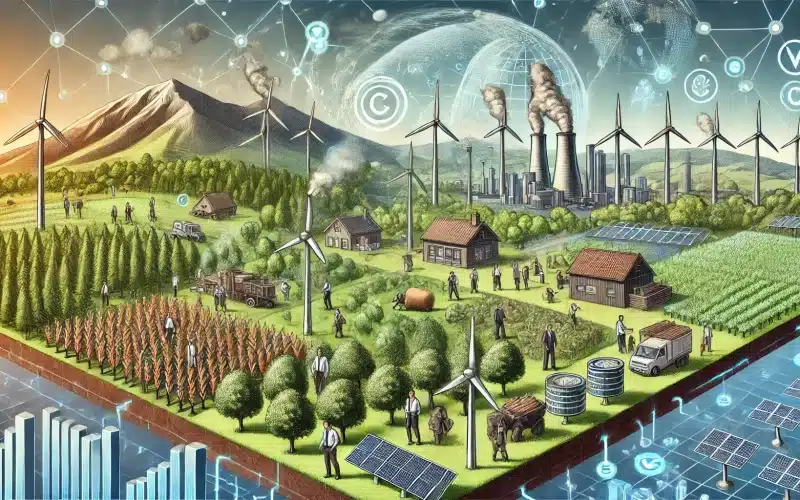
Voluntary Carbon Markets (VCMs) are platforms where companies, organizations, and individuals can buy and sell carbon credits on a voluntary basis. These markets operate outside of regulated or mandatory carbon reduction frameworks and are driven by participants’ desire to offset their carbon emissions voluntarily.
Here’s an in-depth look at what VCMs are and how they work:
How Voluntary Carbon Markets Work
- Carbon Credits: A carbon credit represents the reduction or removal of one metric ton of carbon dioxide or its equivalent (CO2e) from the atmosphere. These credits can be generated through various projects, including reforestation, renewable energy, and energy efficiency projects.
- Project Developers: Organizations or entities develop projects that reduce or remove greenhouse gases (GHGs). These projects are then validated and verified by independent third parties to ensure they meet certain standards and actually deliver the promised environmental benefits.
- Standards and Verification: There are several standards for validating and verifying carbon credits, such as the Verified Carbon Standard (VCS), Gold Standard, and the Climate Action Reserve. These standards ensure that the credits are real, measurable, permanent, and additional (i.e., the reductions would not have occurred without the project).
- Buyers and Sellers: In the voluntary market, buyers (companies, organizations, or individuals) purchase carbon credits to offset their emissions. Sellers are typically the project developers or brokers who facilitate the sale of these credits.
- Marketplaces: There are various online platforms and exchanges where carbon credits can be bought and sold. These include platforms like Climate Impact X, Verra, and the Gold Standard Marketplace.
Benefits of Voluntary Carbon Markets
- Corporate Social Responsibility (CSR): Companies use VCMs to demonstrate their commitment to sustainability and climate action by offsetting their carbon footprint.
- Environmental Impact: By funding carbon reduction projects, buyers help drive environmental benefits such as reforestation, improved air quality, and the preservation of biodiversity.
- Flexibility: Unlike mandatory markets, VCMs provide flexibility for entities to choose projects that align with their values and sustainability goals.
Challenges and Criticisms
- Quality and Integrity: Ensuring the integrity of carbon credits is a major challenge. There have been instances of credits being sold that did not represent real, additional, or permanent reductions.
- Market Fragmentation: The voluntary market is less standardized than regulated markets, leading to variations in the quality and type of credits available.
- Regulatory Uncertainty: Changes in regulations and the potential for new mandatory schemes can impact the voluntary market.
Real-life Examples of Voluntary Carbon Markets
Here are a few real-life examples of how voluntary carbon markets are being used:
1. Microsoft’s Carbon Neutrality
Microsoft has been carbon neutral across the world since 2012, in part by participating in the voluntary carbon market. The company purchases carbon credits from various projects, including reforestation and renewable energy projects, to offset its carbon emissions. Microsoft has also committed to becoming carbon negative by 2030, which involves removing more carbon from the atmosphere than it emits.
2. Delta Air Lines
Delta Air Lines has committed to carbon neutrality from March 2020 onwards. To achieve this, the airline invests in voluntary carbon credits from projects that reduce emissions, such as forest conservation and landfill gas projects. Delta’s approach includes both reducing its direct emissions and offsetting the remaining emissions through the voluntary carbon market (S&P Global).
3. Shell’s Nature-Based Solutions
Shell invests in nature-based projects as part of its strategy to offset its carbon emissions. These projects include reforestation and forest conservation initiatives. By purchasing carbon credits from these projects, Shell aims to compensate for the emissions that are difficult to eliminate in its operations. One notable project is the Katingan Mentaya Project in Indonesia, which protects and restores tropical peatland (World Economic Forum).
4. Apple’s Forest Conservation Efforts
Apple has invested in forest conservation projects to offset the carbon emissions from its supply chain. These projects include the Conservation Fund’s working forests in the United States. By protecting these forests, Apple helps to sequester carbon dioxide and preserve biodiversity, contributing to its goal of making its entire supply chain carbon neutral by 2030.
5. South Pole and the Kariba REDD+ Project
South Pole, a leading provider of climate solutions, manages the Kariba REDD+ Project in Zimbabwe. This project aims to reduce emissions from deforestation and forest degradation while promoting sustainable development. It protects nearly 785,000 hectares of forest and supports local communities. Carbon credits generated from this project are sold on the voluntary carbon market to fund its activities.
Recent Developments
In recent years, the voluntary carbon market has seen significant growth and development. New integrity guidelines have been introduced to address quality concerns, and there is increasing interest from policymakers and regulators in supporting the market’s development. The World Economic Forum and other organizations are actively promoting the use of VCMs as part of broader climate strategies.
